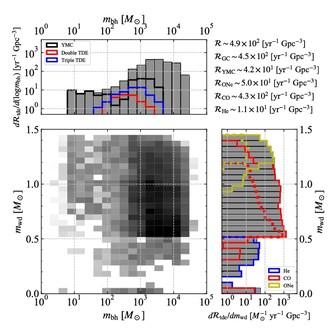
In a tidal disruption event (TDE), a star is torn apart by strong gravity of a black hole (BH). The star can be a white dwarf (WD). WD TDEs are one of promising multi-messenger sources; they can emit electromagnetic waves, gravitational waves, neutrinos, and cosmic rays. They will be also a useful probe for intermediate mass BHs (IMBHs), the missing link between stellar-mass BHs and supermassive BHs. However, no conclusive WD TDE has been identified so far despite of its importance.
A reason for the unidentification is that it is unknown what BH and WD masses WD TDEs typically have. Since BH and WD masses sensitively affect observational features of WD TDEs, such as luminosity, temperature and evolution timescale, they are crucial to identify WD TDEs. Previous theoretical works calculated the total WD TDE rate in the local universe by using numerical simulations. However, they did not obtain the BH and WD mass distributions, since a small number of WD TDEs happen in their numerical simulations. The team led by Mirek Giersz from CAMK created MOCCA-Survey database I, star cluster models with unprecedentedly large-size data. Star clusters are promising sites of WD TDEs. Owing to the large-size data, a large number of WD TDEs happen in the models.
Japanese-Polish-German team including Mirek Giersz investigated WD TDEs, utilizing the database. The authors found that the total WD TDE rate in the local universe can be up to 500 yr^-1 Gpc^-3, 50 times larger than previously obtained. This means that the next-generation optical survey, such as the Large Synoptic Survey Telescope, can detect up to 500 WD TDEs each year. Surprisingly, heavy WDs with more than 1 solar mass occupy 20% of WD TDEs, despite of its small population. This is because heavy WDs preferentially sink into IMBHs in star clusters due to cluster dynamics. This results show that WD TDE observers should pay attentions to heavy WD TDEs, not noticed so far.
Read the original paper:
Figure caption: The WD TDE rate density in the local universe. The bottom left panel shows the 2 dimensional distribution of BH and WD masses. Gray histograms in the top left and bottom right panels indicate the BH and WD mass distributions, respectively.






